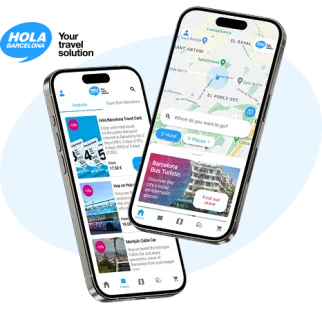Barcelona Pavilion
One of the four canonical pieces of the modern architecture movement
The Barcelona Pavilion is an exact replica of the pavilion that represented the progressive and democratic Germany of the Weimar Republic at the 1929 Barcelona International Exposition. The pavilion is considered to be one of the four canonical pieces of the modern architecture movement, along with the Bauhaus building by Walter Gropius, Villa Savoye by Le Corbusier and Fallingwater by Frank Lloyd Wright.

Barcelona Bus Turístic, on the Hola Barcelona app
Your app for visiting the city with the Barcelona Bus Turístic: routes, stops and the most iconic places. A comfortable way to carry your tickets too!
Mies’s maxim: ‘less is more’
The building has four different zones: the central space, the administration area, and the uncovered spaces of the main terrace and the south patio. However, the pavilion is famous for the fusion of its spaces and the express wish of its creators Ludwig Mies van der Rohe and Lilly Reich to blur the continuity of the interior and the exterior. The result is a milestone in the history of modern architecture that is fully in line with Mies’s maxim of ‘less is more’: a fluid space in continuous transition that plays with the transparency of its glass, the reflection of its water and its various types of marble and onyx to transmit the concepts of freedom and progress inherent to the new German republic.
Located at the bottom of Montjuïc Mountain, next to the Magic Fountain
The original pavilion was disassembled at the end of the exposition, in 1930, but thanks to its status as a key piece of 20th-century architecture, it was faithfully reconstructed in the 1980s at its original location at the bottom of Montjuïc next to the Magic Fountain.
The pavilion is now managed by Fundació Mies van der Rohe, a foundation created by Barcelona City Council in 1983 with the initial objective of reconstructing the building. Now, in addition to conserving and publicising the pavilion, the foundation organises temporary exhibitions and visits for tourists.
For the most curious of you
- Did you know? Ludwig Mies van der Rohe designed a metal and leather chair for the pavilion. It went on to become a design icon that is still made to this day: the Barcelona Chair.
- Local’s tip: If you are passionate about architecture, Fundació Mies van der Rohe organises guided visits with full details and anecdotes about the building.
- A must: For those interested in architecture and the artistic currents of the 20th century.












